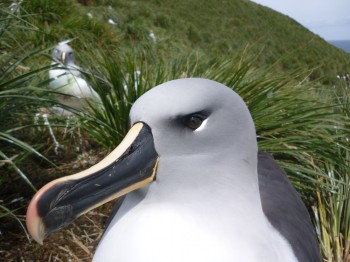Pedro Alvito (MARE-Marine and Environmental Research Centre, University of Coimbra, Portugal) and colleagues have written in the journal Polar Biology on the squid diet of non-breeding Black-browed Thalassarche melanophris and Grey-headed T. chrysostoma Albatrosses
The paper’s abstract follows:
“The food and feeding ecology of albatrosses during the nonbreeding season is still poorly known, particularly with regard to the cephalopod component. This was studied in black-browed Thalassarche melanophris and grey-headed T. chrysostoma albatrosses by analysing boluses collected shortly after adults returned to colonies at Bird Island, South Georgia (54°S, 38°W), in 2009. Based on stable isotopic analyses of the lower beaks, we determined the habitat and trophic level (from δ13C and δ15N, respectively) of the most important cephalopods and assessed the relative importance of scavenging in terms of the albatrosses’ feeding regimes. Based on lower rostral lengths (LRLs), the main cephalopod species in the diets of both albatrosses was Kondakovia longimana, by frequency of occurrence (F > 90 %), number (N > 40 %) and mass (M > 80 %). The large estimated mass of many squid, including K. longimana, suggests that a high proportion (>80 % by mass) was scavenged, and that scavenging is much more important during the nonbreeding season than would be expected from breeding-season diets. The diversity of cephalopods consumed by nonbreeding birds in our study was similar to that recorded during previous breeding seasons, but included two new species [Moroteuthis sp. B (Imber) and ?Mastigoteuthis A (Clarke)]. Based on similarities in LRL, δ13C and δ15N, the squid consumed may have been from the same oceanic populations or region, with the exception of Taonius sp. B (Voss) and , which, based on significant differences in δ15N values, suggest that they may have originated from different stocks, indicating differences in the albatrosses’ feeding regimes.”

Grey-headed Albatross, photograph by Richard Phillips
With thanks to Richard Phillips for information.
Reference:
Alvito, P.M., Rosa, R., Phillips, R.A., Cherel, Y., Ceia, F., Guerreiro, M., Seco, J., Baeta, A., Vieira, R.P. & Xavier, J.C. 2014. Cephalopods in the diet of nonbreeding black-browed and grey-headed albatrosses from South Georgia. Polar Biology DOI 10.1007/s00300-014-1626-3.
John Cooper, ACAP Information Officer, 01 January 2015

 English
English  Français
Français  Español
Español